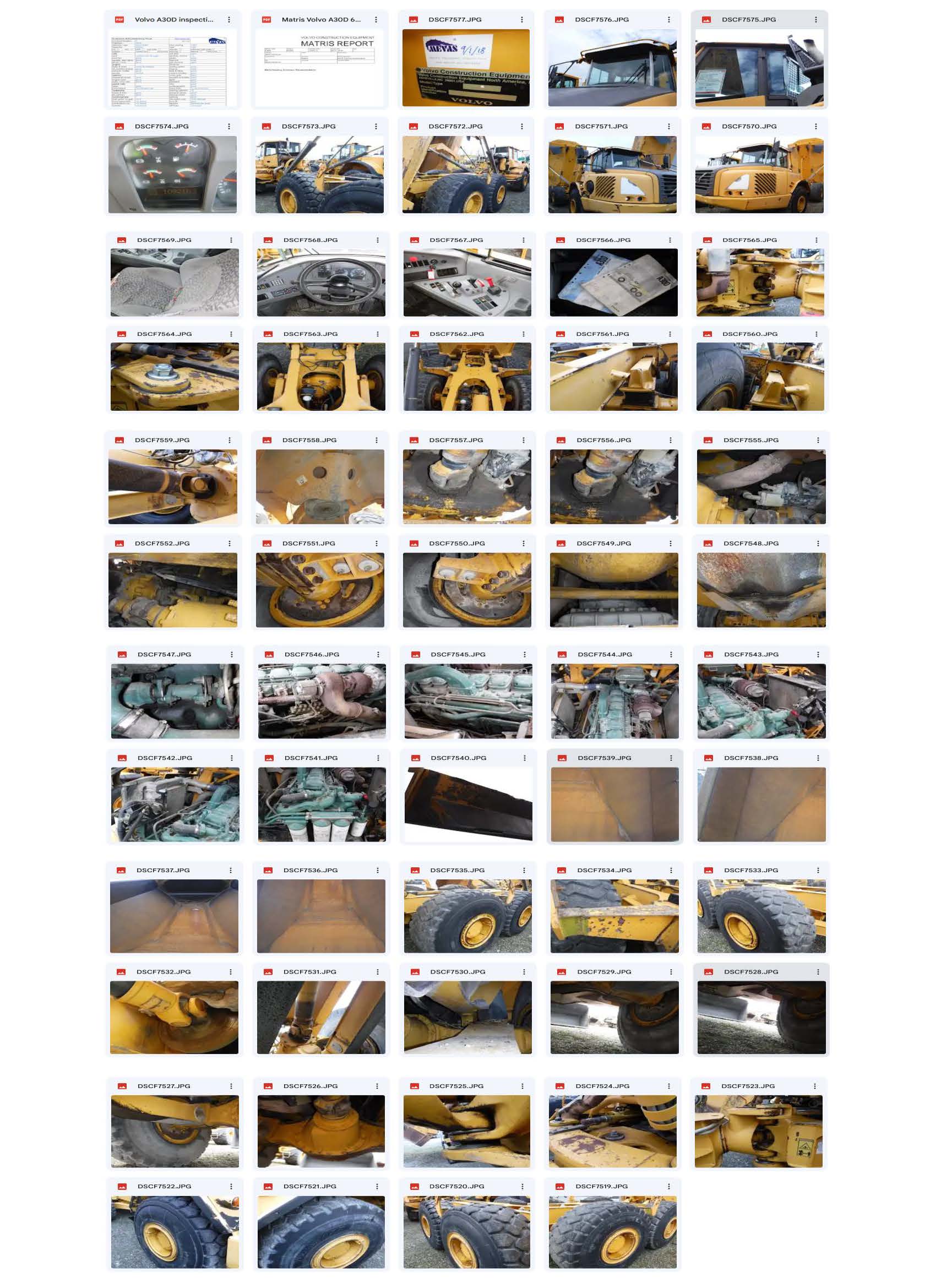If you order an Articulated Dump Truck inspection you would receive a detailed ADT report
- Basic machine information
- Operator station details and condition
- Engine information and condition
- Condition of exterior (chassis and frame, sheet metal, paint)
- Condition of hydraulic system (pumps, performance, hydraulic lines and cylinders)
- Functional test
- Condition of the truck body
- Remaining life of the tires
- Comments and recommendation for repairs
- Transport dimensions

What extras can you order?
Once you receive an offer it will be always for a basic walk-around with functional check. This level is called TA1. On our Checklist-Options page you can find additional services which you can order.
If you have questions about the service please contact the team by Whatsapp or by phone +493520639150. We are happy to answer in detail.
Pictures and video coming with a Mevas-Report
Each machine inspection comes along with 50-80 pictures and in some cases with a short video. In case of interest it is possible to see an articulated dump truck report in detail on our Google-Drive folder.

Video about Volvo dump truck inspection by Mevas
For some kind of machines we made a video about the inspection process. A video of a Volvo A35F inspection is available on our YouTube-Channel.
Other sample reports heavy machinery
Visit our overview for other sample inspection checklists for heavy machinery.
Keep in mind: Report forms are our legal property and copying is a violation of our copyright.
Recommendation for inspections of articulated haulers or dump trucks
Inspecting a used articulated dump truck (ADT) thoroughly is crucial to ensure that it is in good condition and can meet your operational needs. Here’s a comprehensive checklist for a condition inspection of a used articulated dump truck:
Overall Inspection:
- Inspect the truck’s frame for visible signs of damage, rust, or welds.
- Check the body and dump bed for any signs of impact or damage.
Engine:
- Start the engine and check for unusual noises, smoke, or vibrations.
- Inspect for oil leaks around the engine and related components.
- Check the air filter for cleanliness.
Transmission and Drivetrain:
- Test the transmission through all gears, both forward and reverse.
- Check for any unusual noises or vibrations during operation.
- Inspect the condition of the drive shafts and universal joints.
Hydraulic Systems:
- Test the functionality of the dump bed, ensuring smooth and controlled operation.
- Look for leaks in hydraulic hoses, fittings, and connections.
- Check the hydraulic fluid level and condition.
Dump Bed:
- Inspect the dump bed for signs of damage, cracks, or excessive wear.
- Check the hoist mechanism for smooth and even operation.
- Ensure there is no play in the pivot points.
Tires:
- Inspect the condition of the tires for wear, damage, or uneven tread wear.
- Check tire pressure and ensure it meets the manufacturer’s specifications.
- Look for any signs of bulges or cuts.
Brake System:
- Check the condition of the brakes, including pads, drums, and discs.
- Test the brake pedal for responsiveness.
- Inspect brake lines for leaks or damage.
Steering System:
- Test the steering for smooth and responsive operation.
- Check for any unusual noises or play in the steering components.
Suspension System:
- Inspect the condition of the suspension components, including springs, shocks, and bushings.
- Check for any signs of sagging or uneven wear.
- Frame and Chassis:
- Inspect the frame and chassis for cracks or signs of stress.
- Check for any loose or missing bolts in the frame.
- Check the play in articulation pivot and axle hinges
- Cab and Controls:
- Inspect the condition of the cab, looking for damage, rust, or water leaks.
- Test all controls for smooth operation, including the steering and dump bed controls.
- Check the condition of the operator’s seat, seatbelt, and visibility.
- Electrical System:
- Inspect the battery for age and condition.
- Test all lights, indicators, and gauges.
- Check the condition of wiring and connectors.
- Fluids and Lubricants:
- Check the levels of engine oil, transmission fluid, hydraulic fluid, and coolant.
- Inspect the color and condition of these fluids.
- Look for any signs of contamination in the fluids.
- Documentation:
- Request and review maintenance records, service history, and any available inspection reports.
- Check the serial number and verify it against the provided documentation.
- Operational Test:
- Take the articulated dump truck for a test drive to evaluate its performance.
- Pay attention to how it handles, accelerates, and brakes.
- Perform a brake test
- Perform a torque stall test
Always consider having a qualified MEVAS technician or mechanic with experience in heavy equipment perform a thorough inspection if you are not familiar with the specific requirements of articulated dump trucks. Additionally, consulting the manufacturer’s guidelines and specifications for the particular model of the ADT is essential for a comprehensive assessment.
Liste de contrôle pour une tombereau articulé
Tu trouveras ici un exemple de liste de contrôle pour une tombereau articulé. Cette fiche d’inspection est utilisée pour inspecter les machines d’occasion. 60 points sont contrôlés et l’inspecteur note toutes ses observations et décrit les défauts constatés. Tu trouveras une liste de tous les formulaires disponibles ICI. La version de la liste de contrôle présentée ici n’est pas la version la plus récente. Nos rapports d’inspection sont régulièrement mis à jour.

